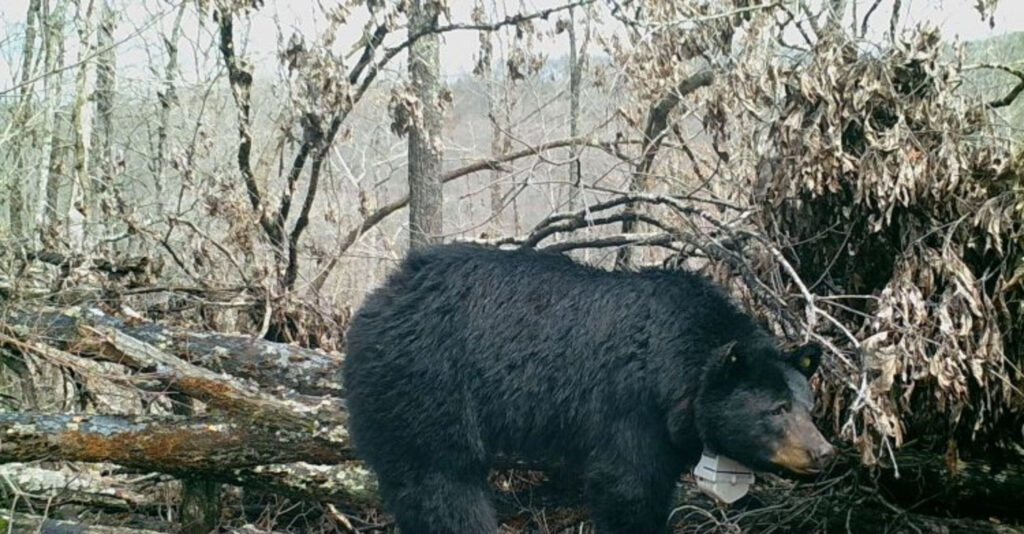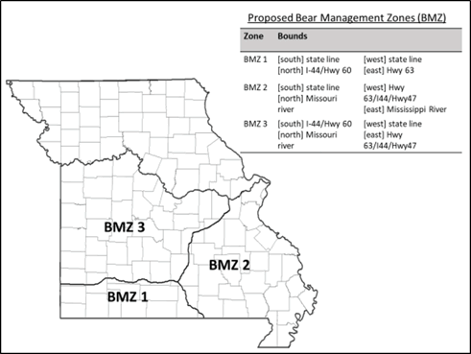Missouri Takes First Step Towards New Black Bear Hunting Season
Missouri may soon have a new black bear hunting season. The Missouri Department of Conservation (MDC) recently proposed a new hunting season following completion of an updated black bear management plan released this past May. The plan resulted from a bear research project partly funded by joint grants from Safari Club International Foundation (SCIF) and it’s Hunter Legacy Fund.
Black bears had all but disappeared from Missouri by the late 1800s due to changes in habitat use and unregulated hunting by settlers. But sightings began to rise after neighboring Arkansas reintroduced black bears to the Ozark and Ouachita Mountains in the western part of that state in 1959. Between 1950 and 1972, only 54 bear sightings in 27 counties were reported to the MDC, an average of 2 each year. Fast forward to the period between 2000 and 2010 when MDC received 512 sightings in 75 counties (51 per year). Sightings further increased through 2017, when 1,341 sightings were reported across 87 counties, averaging 223 per year.

Clearly, bear numbers appeared to have increased, as well as their range, but MDC did not have population estimates, densities or recruitment information to advance their management actions. In partnership with researchers now at the State University of New York, and with financial support from the Federal Aid in Wildlife Restoration Act and partners like SCIF, MDC initiated a black bear population and habitat project to better understand the dynamics and distribution of black bear recovery in Missouri.
Following the initial study, researchers studied bear habitat use, reproduction, and survival rates. Den research involved collaring females and micro-chipping them and their cubs. The data collected helped biologists determine the age at which sows became reproductive, the size of their litters and survival rates of their cubs. That demographic information aided researchers to create a model to estimate current numbers and the trajectory of Missouri’s bear population. The research also allowed biologists to identify suitable habitat for black bears in Missouri, including areas of prime habitat and quantifying movement corridors.
The project took place over a 10-year period, beginning in 2010. SCIF was involved for several years, having visited Missouri for a field visit and again as the MDC hosted the Eastern Black Bear Workshop in 2019. Results were published and peer reviewed in 16 scientific journal publications.

The study results provided the data required to make reliable population estimates and develop an informed bear management plan. MDC currently estimates a bear population of 540 to 840 bears statewide, with a population growth of 9% annually which equates to the population doubling in the next 10 years. Bears also continue to expand their range throughout the southern and central regions of the state.
Population estimates and trajectories also helped define the feasibility and potential schedule for implementing a bear harvest. If a season is established, the population model will provide important data for setting permit and harvest quotas and the state will be broken into 3 Bear Management Zones to assure regionally specific adaptability in the management area.

MDC proposed a 10-day season in October, taking place in three designated bear management zones. Quotas would be set by the Conservation Commission each year. Permits would be issued in a random drawing and be zone specific. Hunters would be able to use firearms or bows. The proposed regulations excluded the use of bait or dogs but that could be reevaluated in the future should management needs change. Hunters would be required to retrieve all usable parts of a bear carcass, tele-check harvested bears the day of harvest and provide MDC with a tooth within 10 days. Initially the season would be open to Missouri residents only.
According to MDC Furbearer Biologist Laura Conlee, the limited black bear hunting will become an essential part of population management as Missouri’s bear numbers continue to grow and is hoped to become an important part of the local hunting culture.
MDC requested public input on the proposed regulations this past May, and SCIF submitted comments, congratulating the MDC on this step.
“This is a perfect example of SCIF’s mission in action, funding on-the-ground research that leads to the successful implementation of a new science-based hunting opportunity and sustainable management tool,” said Joe Goergen, SCIF Conservation Manager.
“We are happy to see black bears once again thriving on the Missouri forest landscape. We look forward to continuing to work with the MDC through the public comment process and thank the Hunter Legacy Fund for making it all happen.”
MDC submitted its finalized recommendations for a black bear hunting season to the MDC Regulations Committee in July. The framework was recently approved at the Conservation Commission meeting on September 4. The Commission will now take final public input from October 16 through November 14 for consideration at their December meeting. If approved again there, the decision would be made effective February 2021 for the earliest possible season in the fall of 2021.
The Hunter Legacy Fund is a group of hunters (and SCI members) dedicated to funding meaningful wildlife conservation projects. Their grant for this project combined with state and other matching funds contributed to a decade long study and multi-million-dollar effort. Their support helped the MDC in its’ effort to finalize a plan to manage a self-sustaining population of black bear, increase bear awareness, minimize human-bear conflict, and provide recreational opportunities.
(Photos & Maps Courtesy of Missouri Department of Conservation)

